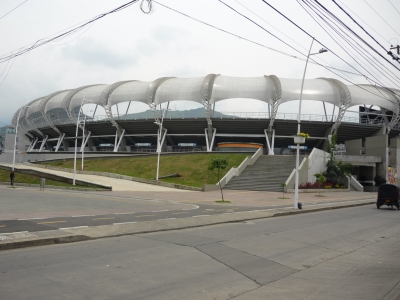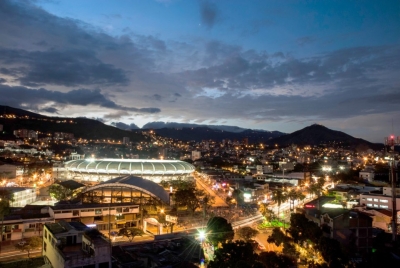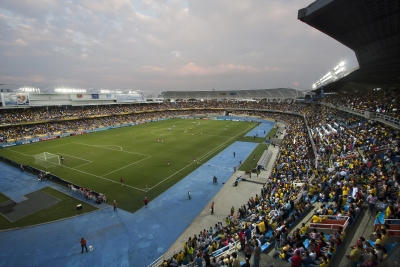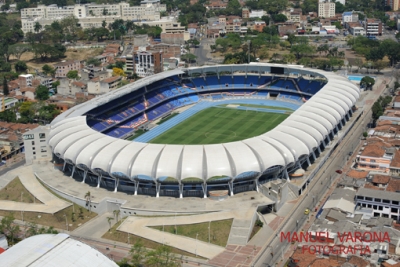PASCUAL GUERRERO OLYMPIC STADIUM
The idea of buildingthe Pascual Guerrero Stadium was conceived in 1930, after a friendly soccer tournament held at the Galilea Stadium (no longer existent) built for the I National Athletic Games in 1928 and located at the Versailles neighborhood of Cali.
Mr. Pascual Guerrero in 1935 asked the department to build a stadium on the campus of San Fernando which was purchased by the city government. It was inaugurated by the President of the Republic, Alfonso Lopez Pumarejo, under the name of Departmental Stadium on July 20th 1937 a date that coincided with the commemoration of the fourth centenary of Santiago de Cali’s founding. As celebration, a friendly soccer tournament was held between Argentina, Cuba, Mexico and Colombia.
In 1948 the first professional soccer game was played on its field and in 1954 the stadium hosted the VII National Games, for which the sport complex that was located next to the stadium was renewed and expanded, that´s when the Olympic Pools began to get called by its official name, San Fernando Sports Complex. The President Gustavo Rojas Pinilla inaugurated the event.
Cali was chosen to host the VI Pan American Games in 1971; thanks to that event the stadium was restructured and adapted to the Olympic standards of the time, there was build an 8 lane athletic track, made of synthetic tartan and spaces for hammer throw and shot put, long jump and pole vault.
The capacity of the stadium was increased in about 45 thousand spectators the lighting facilities were improved and the electronic advertisement board were set. With the accomplishment of the Pan American Games in 1971, this sports complex was called The Pan American Sports Unit.
Therefore, from the 50’s to the 70’s the Pascual Guerrero Olympic Stadium and the sport complex next to it became one of the finest and most modern sport unit of Latin America, that’s why the name “The Sport Capital of America” was given to Cali.
Between 1994 and 1999 renovations were performed in its facilities, the athletic track was adjusted , the north gallery was renewed and also they fixed some problems with; the grass, the field drainage and the location for sports journalists. All these in order to accomplish the Pacific Games held in 1995 and the Copa America in 2001.
For the 43rd South American Athletics Championship in 2005, the material of its track was repaired and approved by the International Association of Athletics Federations (IAAF), which ratified the track and accepted as officials the new marks.
Due to the National Games in 2008, the stadium was renewed again in its tracks, field and adjacent pools. By 2009, new constructions began according to FIFA standards for the FIFA U-20 World Cup that will be held in 2011. As a consequence, bleachers were set up, as well as dressing rooms; suites were built in the eastern stand, VIP Zones in the western stand, a public scoreboard was installed on the north stand, and underground parking in the south stand.
Currently, this venue is the sport training place for the Liga Vallecaucana (Vallecaucana Ligue), Juegos Escolares (School Games) and Intercolegiados (Intercollegiate championships). At its regular season, soccer matches are held for the Professional Colombian Soccer Tournament with the teams of the region; América de Cali and Deportivo Cali.
Apart of being a sport location, in this stadium have taken place international and national concerts, as well as traditional events as the Super Cali Concert Fair, in which contemporary bands and singers of different musical genres are on stage between 25th and 30th December.
Location and access routes
The stadium is located at the traditional San Fernando neighborhood, the center-south of the city, between the traditional Fifth Avenue and Roosevelt Avenue. Next to this venue is the Evangelista Mora Coliseum, the Alberto Galindo Swimming Pools, Making it the San Fernando Sports Complex, also known as the Pan American Sports Complex.
The access from the South or North of the city is by the Fifth Avenue, where mass-transit buses operate and the Parque de las Banderas station is located in front of the stadium. Other access routes are the Ninth Avenue, the Diagonal 34 and the Roosvelt Avenue.






